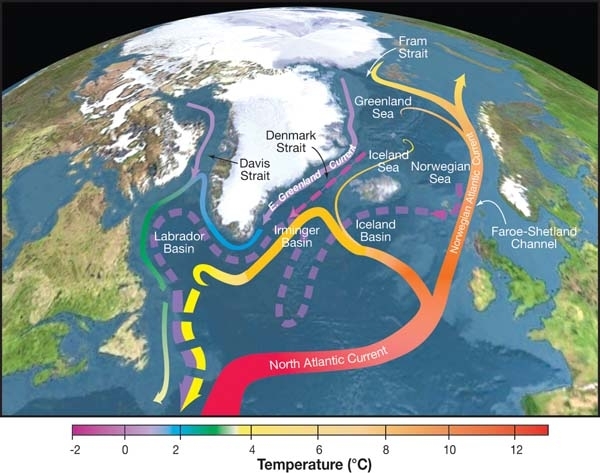The Atlantic meridional overturning circulation (AMOC) is part of the global meridional overturning circulation, and is characterized by a northward flow of warm, salty water in the upper layers of the Atlantic, and a southward flow of colder, deep waters, with the main regions of overturning located in the Nordic and Labrador Seas and the Southern Ocean.[1] The AMOC is an important component of the Earth’s climate system, and is a result of both atmospheric and thermohaline drivers.

Climate change has the potential to weaken the AMOC through increases in ocean heat content and elevated freshwater flows from the melting ice sheets. Oceanographic reconstructions generally suggest that the AMOC is already weaker than it was before the Industrial Revolution,[2][3] although there is a robust debate over the role of climate change versus the circulation’s century-scale and millennial-scale variability.[4][5] Climate models consistently project that the AMOC would weaken further over the 21st century,[6] which would affect average temperature over areas like Scandinavia and Britain that are warmed by the North Atlantic drift,[7] as well as accelerate sea level rise around North America and reduce primary production in the North Atlantic.[8]
Severe weakening of the AMOC has the potential to cause an outright collapse of the circulation, which would not be easily reversible and thus constitute one of the tipping points in the climate system.[9] A shutdown would have far greater impacts than a slowdown on both the marine and some terrestrial ecosystems: it would lower the average temperature and precipitation in Europe, slashing the region’s agricultural output,[10] and may have a substantial effect on extreme weather events.[11] Earth system models used in the Coupled Model Intercomparison Project indicate that shutdown is only likely after high levels of warming are sustained well after 2100,[12][13][14] but they have been criticized by some researchers for what they saw as excessive stability,[15] and a number of lower-complexity studies argue that a collapse can happen considerably earlier.[16][17] On the other hand, paleoceanographic research suggests that the AMOC may be even more stable than what is assumed by most models.[18][19]
References
- Buckley, Martha W.; Marshall, John (2016) Observations, inferences, and mechanisms of the Atlantic Meridional Overturning Circulation: A review Reviews of Geophysics
- Rahmstorf, S., Box, J., Feulner, G. et al. (2015) Exceptional twentieth-century slowdown in Atlantic Ocean overturning circulation Nature
- Caesar, L., McCarthy, G.D., Thornalley, D.J.R. et al. (2021) Current Atlantic Meridional Overturning Circulation weakest in last millennium Nat. Geosci.
- Latif, M., Sun, J., Visbeck, M. et al. (2022) Natural variability has dominated Atlantic Meridional Overturning Circulation since 1900 Nat. Clim. Chang.
- Kilbourne, K.H., Wanamaker, A.D., Moffa-Sanchez, P. et al. (2022) [Atlantic circulation change still uncertain https://www.nature.com/articles/s41561-022-00896-4] Nat. Geosci.
- IPCC (2019) IPCC Special Report on the Ocean and Cryosphere in a Changing Climate
- Lenton TM, Held H, Kriegler E, Hall JW, Lucht W, Rahmstorf S, Schellnhuber HJ. (2008) Tipping elements in the Earth’s climate system Proc Natl Acad Sci
- Osman, M.B., Das, S.B., Trusel, L.D. et al. (2009) Industrial-era decline in subarctic Atlantic productivity Nature
- Rosamund Pearce, Tom Prater (2020) Tipping Points in the Climate System Carbon Brief
- (2020) Atlantic circulation collapse could cut British crop farming University of Exeter
- J. Hansen et al. (2015)Ice melt, sea level rise and superstorms: evidence from paleoclimate data, climate modeling, and modern observations that 2◦C global warming is highly dangerous Atmospheric Chemistry and Physics
- Wei Liu et al. (2017) Overlooked possibility of a collapsed Atlantic Meridional Overturning Circulation in warming climate Science Advances
- P. Bakker et al.(2016) Fate of the Atlantic Meridional Overturning Circulation: Strong decline under continued warming and Greenland melting AGU
- Sigmond, M., Fyfe, J.C., Saenko, O.A. et al. (2020) Ongoing AMOC and related sea-level and temperature changes after achieving the Paris targets Nature
- Valdes, P. (2011) Built for stability nature Geosci.
- Johannes Lohmann and Peter D. Ditlevsen (2021) Risk of tipping the overturning circulation due to increasing rates of ice melt PNAS
- Boers, N. (2021) Observation-based early-warning signals for a collapse of the Atlantic Meridional Overturning Circulation Nat. Clim. Chang.
- He, F., Clark, P.U. (2022) Freshwater forcing of the Atlantic Meridional Overturning Circulation Nat. Clim. Chang.
- Kim, SK., Kim, HJ., Dijkstra, H.A. et al. (2022) Slow and soft passage through tipping point of the Atlantic Meridional Overturning Circulation in a changing climate Clim Atmos Sci